Amharic input method with SERA. For more information, see the page http://www.geez.org/IM/.
Input Method for Arabic simulating Arabic keyboard (MS Windows).
Assamese input method by ITRANS transliteration. For the detail of ITRANS, see the page: <http://www.aczoom.com/itrans/>
Bengali input method by ITRANS transliteration. Itrans Bengali Keymap Layout created by Avinash Chopde in accordance with the details in the following link: http://www.aczoom.com/itrans/beng/node4.html Key Summary: The consonant alphabets are represented as half-characters by default i.e. k = ক্ . To complete the character please use 'a' representing 'অ' i.e. ka=ক. Consonant conjuncts can be created by writing the consonant characters in sequential order. To complete the conjunct either 'অ' or any other dependent vowel [অ (a), া(aa), ি(i), ী(ii), ু(u), ূ(uu), ে(e), ৈ(ai), ো (o), ৌ (au)] needs to be added at the end. E.g. ক্রিয়া = k+r+i+Y+A To write 'Khaanda-ta' (ৎ) use the key combination : t.h Detailed instructions for typing are available at the above mentioned link The following keysequences are not defined in the mentioned page, but added for users' sake: Ch JN shh yh dny LLi L^i RRI R^I LLI L^I # $ ^ * ] S- C-@
Bengali input method simulating Unijoy keyboard layout. <http://ekushey.org/projects/shadhinota/uni_joy.html>
Tibetan input method based on EWTS. This implementation is based on THDL Extended Wylie Transliteration Scheme Version 2.0 <http://www.thdl.org/collections/langling/ewts/ewts.php>.
Tibetan input method based on the Wylie transliteration. It is actually the re-implementation of Emacs' tibetan-wylie input method, and is slightly different from Extended Wylie Transliteration Scheme (EWTS). The exact EWTS-based input method is in bo-ewts.mim.
Provide utilities for CJK input methods. This is acutually not a standalone input method, but is expected to be included in the other input method (e.g. zh-py). The fullwidth mode is turned on by typing ">>", and turned off by typing "<<". The single fullwidth mode is turned on by typing "Z". In this mode, any key typed is converted to the fullwidth character and is inserted, then the mode is turned off.
Not yet officially released.
Dhivehi input method simulating the Dhivehi phonetic keyboard. The layout is approved by the Molvidian Ministry of Communication, Science and Technology. <http://www.mcst.gov.mv/News_and_Events/xpfonts.htm>
Input method for Greek simulating Greek keyboard.
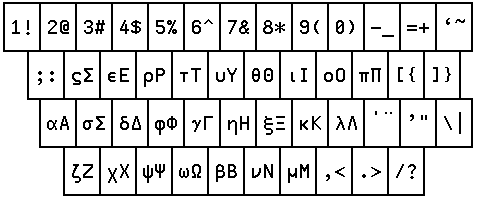
Keyboard Layout
Farsi input method simulating ISIRI 2901-1994 keyboard layout. This is for typing Farsi by Arabic characters.
Not yet officially released.
Global variable and command definitions. This is actually not an input method, but provides documents, default values of global variables, and default key-bindings of global commands.
Mizuochi input method for classical Greek. ------------------------------------- character capital small ------------------------------------- alpha A a beta B b gamma G g delta D d epsilon E e zeta Z z eta H h theta Q q iota I i kappa K k lamda L l mu M m nu H n xi X x omicron O o pi P p rho R r sigma S s final sigma j tau T t upsilon U u phi F f chi C c psi Y y omega W w ------------------------------------- sampi ! digamma # stigma $ koppa & % ------------------------------------- ------------------------ mark key ------------------------ ypogegrammeni J psili ' or v dasia ` or V oxia / varia ? perispomeni \ or ^ dialytika " ano teleia : erotimatiko ; ----------------------
Gujarati input method by ITRANS transliteration. For the detail of ITRANS, see the page: <http://www.aczoom.com/itrans/>
Input method for Hebrew simulating Hebrew keyboard.
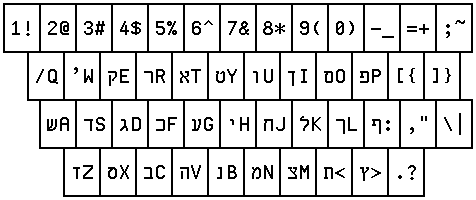
Keyboard Layout
Hindi input method by ITRANS transliteration. For the detail of ITRANS, see the page: <http://www.aczoom.com/itrans/>
Hindi input method with `typewriter' method. Still experimental.
Input method for Croatian. Simulating Croatian Latin keyboard on American keyboard.
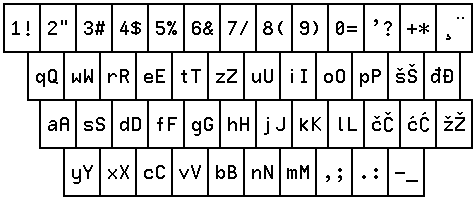
Keyboard Layout
Input method for Armenian. Simulating Eastern Armenian keyboard on American keyboard.
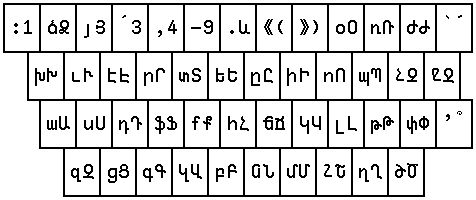
Keyboard Layout
Input method for English using ISPELL as a spell checker. It uses the loadable module libmimx-ispell.so to communicate with ISPELL program. You can check the spelll of typed word by TAB key. Not for an actual use, but for demonstrating what can be done by the m17n input method.
Japanese input method with Anthy as a kana-kanji converter. Typed roma-ji is at first converted to Hiragana, and Space key converts the Hiragana sequences to Kanji-Hiragana mixed sequence. This input method uses the loadable module libmimx-anthy.so to communicate with Anthy. For more detail about Anthy, see the page <http://sourceforge.jp/projects/anthy/>.
Input method for Japanese with TCODE.
Input method for Japanese with TRY-CODE. See <http://www.m17n.org/ntakahas/npx/aggressive/aggressive4.en.html> for the details.
Input method for Georgian simulating Georgian keyboard.
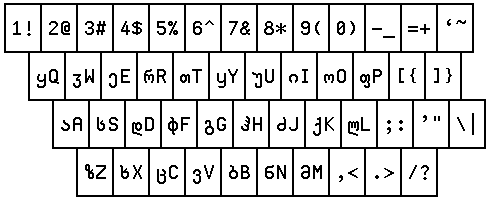
Keyboard Layout

Transliteration input method for Kazakh written in the Arabic script
1 2 3 4 5 6 7 8 9 10 11 12 13 14 15 16 17 a A b v g R d e j z y k q l m n N 18 19 20 21 22 23 24 25 26 27 28 29 30 31 32 33 o O p r s t w u U f H h c S I i
Input method for Kazakh written in the Cyrillic script. Simulating Kazakh keyboard.
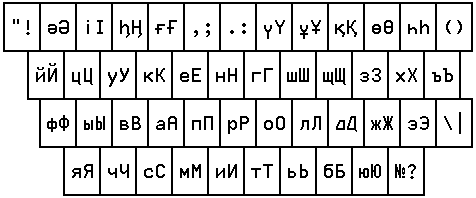
Keyboard Layout
Khmer input method suggested by Dr. Yannis Haralambous.
Kannada input method by ITRANS transliteration. For the detail of ITRANS, see the page: <http://www.aczoom.com/itrans/> There are few changes from the ITRANS by Hari Prasad Nadig, Kannada l10n Team, kannada.l10n@gmail.com <http://kannada.sourceforge.net> on 18 Aug 2005.
Hangul input method with 2벌식. This input method uses this keyboard layout:
| KEY: | r | R | s | e | E | f | a | q | Q | t | T | d | w | W | c | z | x | v | g | k | i | j | p | P | u | h | y | n | b | m | l | o | O |
| 한글: | ㄱ | ㄲ | ㄴ | ㄷ | ㄸ | ㄹ | ㅁ | ㅂ | ㅃ | ㅅ | ㅆ | ㅇ | ㅈ | ㅉ | ㅊ | ㅋ | ㅌ | ㅍ | ㅎ | ㅏ | ㅑ | ㅓ | ㅔ | ㅖ | ㅕ | ㅗ | ㅛ | ㅜ | ㅠ | ㅡ | ㅣ | ㅐ | ㅒ |
Input method for Korean Hangul using Romaja keys. The roman-transliteration rules follows that of IIIMF shown in this page: http://www3.sympatico.ca/d.moser/hangul.html
Input method for Latin script with postfix modifiers.
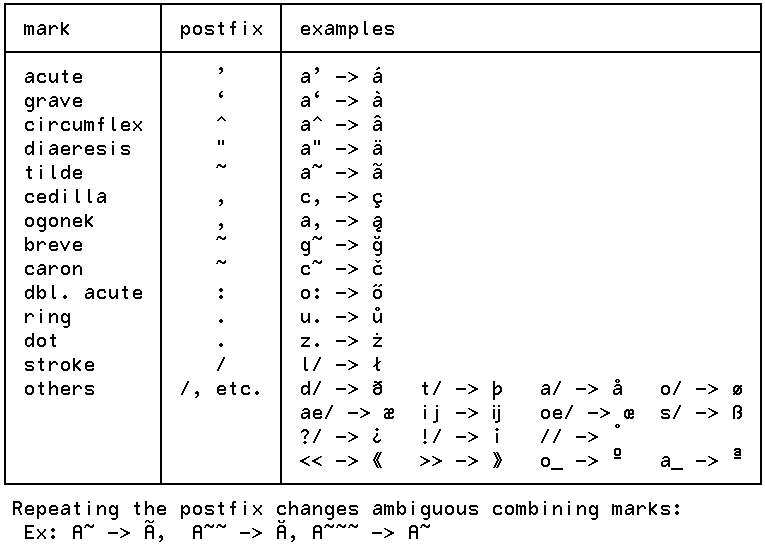
Input method for Latin script with prefix modifiers.
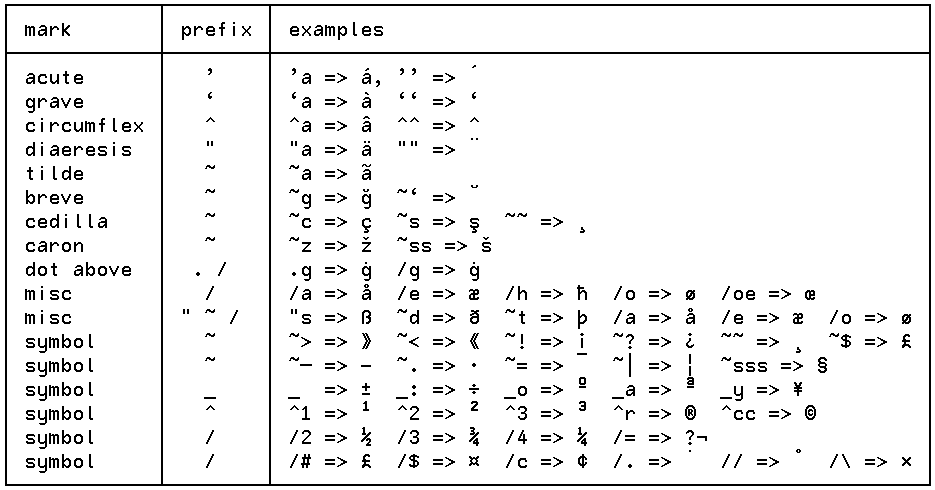
Input method for Lao using Lao keyboard layout.
Lao input method using Lao-Roman transliteration.
Malayalam input method by ITRANS transliteration. For the detail of ITRANS, see the page: <http://www.aczoom.com/itrans/>
Myanmar input method simulating the Myanmar keyboard.
Oriya input method by ITRANS transliteration. For the detail of ITRANS, see the page: <http://www.aczoom.com/itrans/>
Panjabi input method by ITRANS transliteration. For the detail of ITRANS, see the page: <http://www.aczoom.com/itrans/>
Generic input method using RFC1345 mnemonics. Input characters by typing & (ampersand) followed by two or three keys. It doesn't include RFC1345 mnemonics for ASCII and Control-1 characters (U+0000..U+009F) except for & itself which can be input by typing & twice.
Input method for Russian by simulating the Russian keyboard.
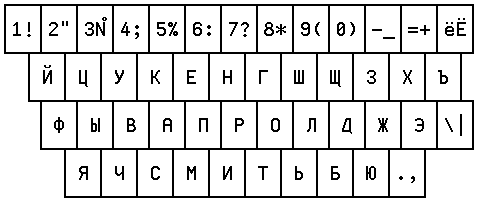
Keyboard Layout
Input method for Russian simulating the keyboard layout based on Roman transcription by phonetic resemblance.
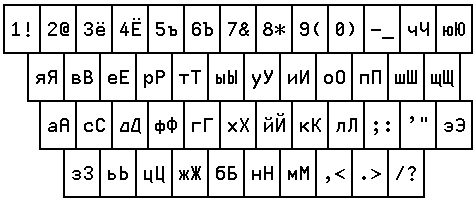
Keyboard Layout
Input method for Russian simulating the keyboard layout based on Roman transcription by phonetic resemblance.
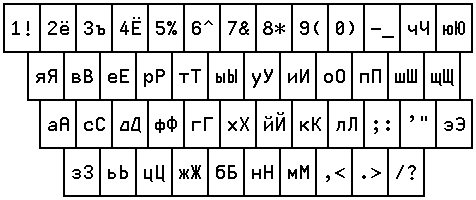
Keyboard Layout

Sinhala input method using transliteration. The transleteration system is based on the Samanala version 2 developed by Prasad Dharmasena. <http://www.nongnu.org/sinhala/doc/transliteration/sinhala-transliteration_1.html>
Sinhala input method based on SLS 1134 Rev. 2:2004. <http://www.fonts.lk/doc/sin-kbd-layout4.pdf> This input method requires surrounding text support.
Not yet officially released.
Sinhala input method based on SLS 1134 Rev. 2:2004. <http://www.fonts.lk/doc/sin-kbd-layout4.pdf> This input method uses preedit rather than surrounding text.
Input method for Slovak simulating the standard Slovak keyboard.
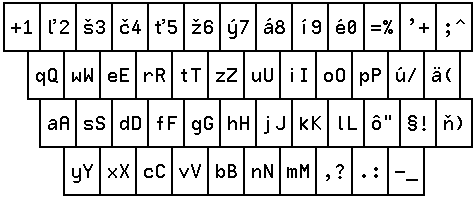
Keyboard Layout

Input method for Serbian. Simulating Serbian Cyrillic keyboard on American keyboard.
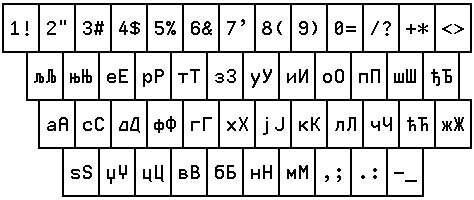
Keyboard Layout
Swedish input method with postfix modifiers.
Syriac input method simulating the Syriac phonetic keyboard. The keyboard layout was published by Beth Mardutho: The Syriac Institute. <http://www.BethMardutho.org>
Tamil input method by ITRANS transliteration. For the detail of ITRANS, see the page: <http://www.aczoom.com/itrans/>
Telugu input method by ITRANS transliteration. For the detail of ITRANS, see the page: <http://www.aczoom.com/itrans/>
Thai input method simulating the Kesmanee keyboard with WTT 2.0 input sequence correction. The correction algorithm follows the one shown in the following <http://linux.thai.net/~thep/th-xim/>
Thai input method simulating the Pattachote keyboard with WTT 2.0 input sequence correction. The correction algorithm follows the one shown in the following <http://linux.thai.net/~thep/th-xim/>
Thai input method simulating the TIS-820.2538 keyboard with WTT 2.0 input sequence correction. The correction algorithm follows the one shown in the following <http://linux.thai.net/~thep/th-xim/>
Uyghur input method simulating an Uyghur keyboard layout. Based on <http://tarim.yulghun.com/docs/src/uyghur.xkb>
Input method for Unicode BMP characters using hexadigits. Type C-u followed by four hexadecimal numbers [0-9A-Fa-f] of a Unicode character code.
Vietnames input method using the TELEX key sequence.
Typing Backslash ('\') toggles the normal mode and English mode.
The following variables are customizable:
tone-mark-on-last: control tone mark position in equivocal cases
backspace-is-undo: control the action of Backspace key (delete or undo)
Vietnames input method using the VIQR key sequence.
Vietnames input method using the VNI key sequence. It is based on the information at: http://vietunicode.sourceforge.net/inputmethod.html
Input method for Bopomofo.
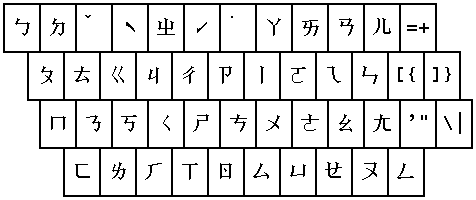
Keyboard Layout
Chinese input method with CANGJIE method. In addition to Chinese characters, fullwidth latin characters and symbols are available in fullwidth mode (turns on and off by ">>" and "<<" respectively). This mode can also be turned on temporarily by typing "Z".
Input method for Chinese Pinyin characters. Note that it's not for inputting Han characters.
Chinese Big5 input method with Pinyin sequence. In addition to Chinese characters, fullwidth latin characters and symbols are available in fullwidth mode (turns on and off by ">>" and "<<" respectively). This mode can also be turned on temporarily by typing "Z".
Chinese GB2312 input method with Pinyin sequence. In addition to Chinese characters, fullwidth latin characters and symbols are available in fullwidth mode (turns on and off by ">>" and "<<" respectively). This mode can also be turned on temporarily by typing "Z".
Chinese input method with Pinyin sequence. In addition to Chinese characters, fullwidth latin characters and symbols are available in fullwidth mode (turns on and off by ">>" and "<<" respectively). This mode can also be turned on temporarily by typing "Z".
Chinese input method with QUICK method. In addition to Chinese characters, fullwidth latin characters and symbols are available in fullwidth mode (turns on and off by ">>" and "<<" respectively). This mode can also be turned on temporarily by typing "Z".
Chinese Big5 input method with Pinyin+Tone sequence. In addition to Chinese characters, fullwidth latin characters and symbols are available in fullwidth mode (turns on and off by ">>" and "<<" respectively). This mode can also be turned on temporarily by typing "Z".
Chinese GB2312 input method with Pinyin+Tone sequence. In addition to Chinese characters, fullwidth latin characters and symbols are available in fullwidth mode (turns on and off by ">>" and "<<" respectively). This mode can also be turned on temporarily by typing "Z".
Chinese input method with Pinyin-and-tone sequence. In addition to Chinese characters, fullwidth latin characters and symbols are available in fullwidth mode (turns on and off by ">>" and "<<" respectively). This mode can also be turned on temporarily by typing "Z".
Provide utilities for Chinese input methods. This is acutually not a standalone input method, but is expected to be included in the other Chinese input method (e.g. zh-py).
